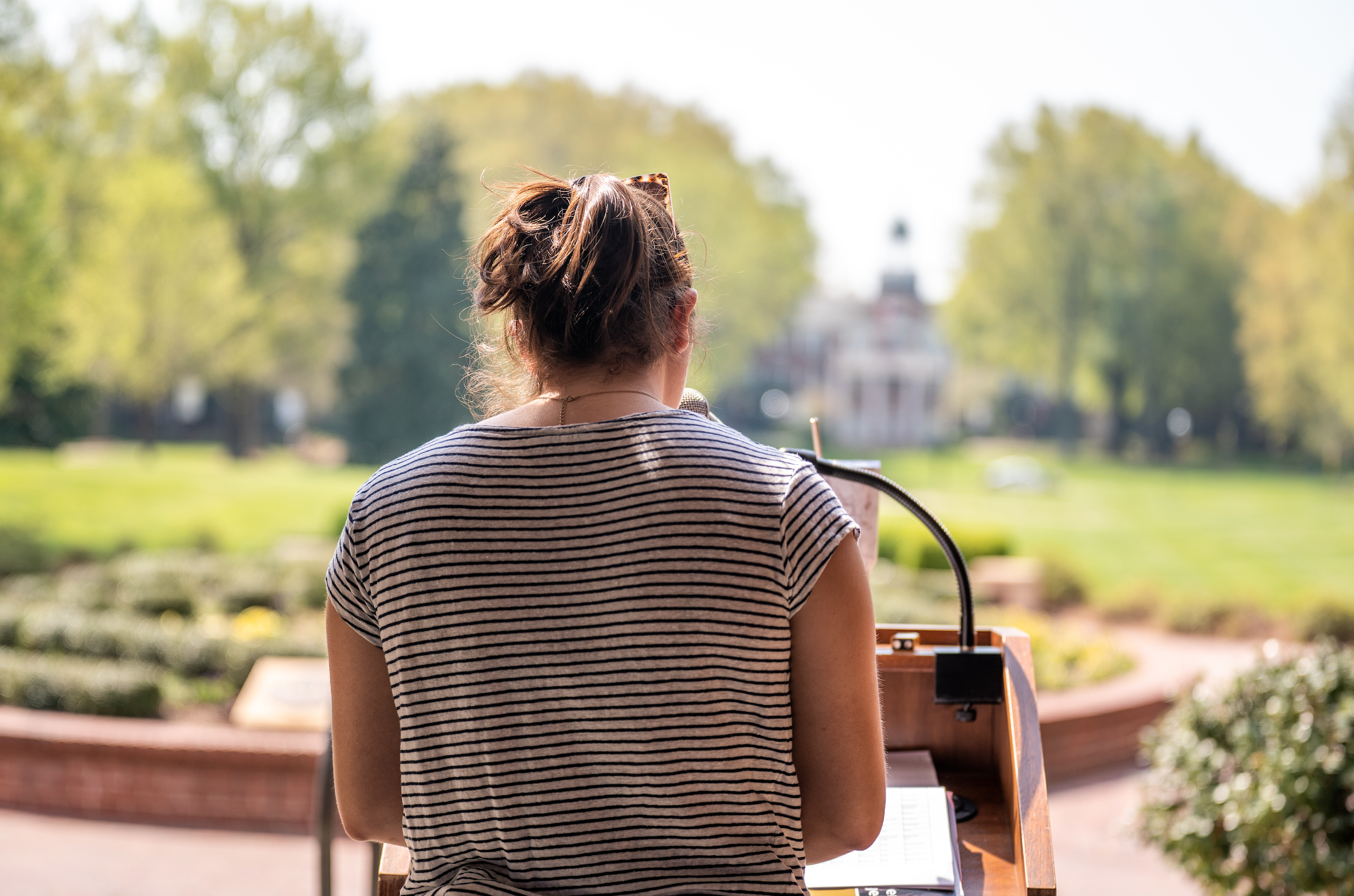Elon Hillel led the university community in honoring and remembering the millions of lives lost in the Holocaust through a series of events to commemorate Yom HaShoah.
Rachel Fultonberg ’21 stood on the front steps of Moseley Center, reading name after name from a large binder. With every name came a painful reminder of a horrific period in human history.
The names were those of some of the millions of people killed during the Holocaust. Fultonberg was one of several members of the university community to volunteer for the Reading of the Names on Thursday. The ceremony was part of Elon Hillel’s two-day commemoration of Yom HaShoah, or the “Day of Remembrance of the Holocaust and Heroism.”

As Fultonberg read hundreds of names from the binder, she came across the name of Anne Frank, the diarist who famously documented her life in hiding during the Holocaust. It was a historical connection that helped Fultonberg better understand the true gravity of what happened to millions of people during World War II.
“It’s just so disheartening to see how many names there are because we know 6 million Jews perished, but when you see all the names and you’re reading them, it’s a whole different feeling,” she said.
Those who attended the ceremony could also read the personal stories of hundreds of Holocaust victims and survivors and take a variety of colorful ribbons, each representing a different population of the 11 million people who were killed. The event served as a commemoration of those lives, but also a reminder about the dangers of allowing hatred and bigotry to persist.

“The more we can remember the atrocities and the more we can remember our humanity, the more I hope we can remember what to do to come together and prevent the atrocities,” said Betsy Polk, director of Jewish Life at Elon.
Prior to the Reading of the Names, students, faculty and staff gathered for the Ceremony of Remembrance, an event hosted live on the Elon Hillel Facebook page. The ceremony offered a space to remember the victims of the Holocaust, as speakers led prayers and shared quotes and stories related to the events. The audience also heard poetry written by survivors, onlookers and others who lived through the Holocaust.
“Bringing together all of those different points of view through poetry, which can be such a powerful medium, is a different way of introducing the Holocaust,” said Hillary Zaken, assistant director of Jewish Life for development and strategic communications. “It’s a powerfully lyrical reminder of creating beauty in times of extreme pain.”
Wednesday night, the community was invited to hear from Zev Harel, who shared his experience as a Holocaust survivor in the virtual event, “I am the boy in the picture.” Harel told his story in a live broadcast on the Elon Hillel Facebook page while accompanied by Bernice, his wife of 55 years.
Born in 1930 in Transylvania, Romania, Harel was in the fifth grade when Hungarian troops invaded his village, forcing him to drop out of school and stay home. In 1944, Harel and the rest of his village were relocated to ghettos where Jewish people were held in isolation from the non-Jewish population.
Harel and his family spent three months in a ghetto before cattle cars arrived to take residents to concentration camps in April 1944. Harel remembers older members of the village being left behind in one of the ghetto’s buildings because they were unfit to make the journey. He recalled watching the building burn to the ground as the cattle car doors closed and he was transported to Auschwitz concentration camp.
“That night was such a beautiful night. Looking up at the sky, the beautiful sky, with all the stars,” he said. “But along with the beauty, there was also the stench.”
Upon arrival at Auschwitz, men and women were separated, and each prisoner was evaluated by an S.S. officer. Harel lied about his age, saying he was 17 instead of 14 years old. It was a lie that saved his life, as prisoners younger than 15 were immediately killed. More than a million people lost their lives at Auschwitz after they were deemed unfit to work at the concentration camp.
Harel was sent to work on construction in Ebensee, a town in Austria. The cruelty of the S.S. officers and the harshness of the conditions made the work-filled days unbearable, he said.
“They would do all kinds of evil things,” said Harel. “They had control over us. There was no discipline of any kind to hold them from doing any of the bad things they wanted to do. I don’t know how, but I managed to do what I had to do each day.”
On May 6, 1945, the United States Third Cavalry arrived to free Harel and the other prisoners. Harel was rescued from a roadside ditch and taken to a nearby hospital to recover.
In the years following his rescue, Harel would join the Palestine Jewish Brigade and fight in Israel’s War of Independence, earn his undergraduate degree from Hebrew University, continue his studies in the United States and teach at Cleveland State University until retirement.
In Wednesday’s event, Harel expressed his gratitude for those in the United States Army and those who work with the Holocaust Remembrance Museum. He urged anyone listening to reflect on and learn from his story.
“Do what you can, so whenever you have the opportunity, no bad things should occur,” said Harel. “Aspire to achieve and do all the good things you can do. Look back and see that you have done what is righteous.”



